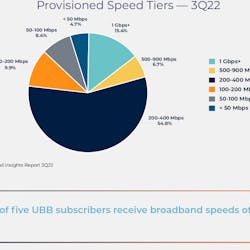The massive change in what cable operators deliver to subscribers and how they send it is having significant impact on the testing and monitoring of cable's networks.These changes are across the board. They include the decentralization of programming sources, the increasing volume of monitoring data coming from the field, an economy that is making operators favor better testing of existing plan over rebuilding and new and sophisticated equipment that makes testing in the field easier and more comprehensive, even for less experienced technicians.Ironically, one of the main impacts of all of these changes is to lead operators to return to their test, measurement and monitoring roots. Jack Webb, a product manager for Sunrise Telecom ((PINK:SRTI), said there is renewed interest in system sweeps. That procedure had been de-emphasized as amplifier cascades got shorter and the need, at least for a while, faded.That fading has reversed itself, according to Webb. "We find that the practice of sweeping is good preventive maintenance," he said. "It shows problems before they affect customers. You find loose connectors, cracked housing and workmanship issues. You find water ingress into housings, things like that. These are things that -- if they are let go -- cause outages."This is all the more important, Webb pointed out, because of the digitization of modern systems. Networks now fail hard -- essentially, they work fine until they don’t work at all -- instead of experiencing the gradual fade of older systems. This can hide nascent problems, since the de facto early warning system of deteriorating quality no longer exists. This makes it vital that test and monitoring regimes gather enough information to make it possible to find these lurking threats.The focus going forward -- perfecting the test, monitoring and measurement that goes on in the field and in the home -- dovetails with two things. The first is the refocusing of attention from quality of service (QoS) to quality of experience (QoE). The shift can be broadly defined as more of an emphasis on the entirety of a subscriber’s experience -- what he or she actually is hearing and seeing -- than a focus on specific metrics.The second element is economics. The poor economy of the past few years is leading operators to squeeze as much as they can from existing infrastructure. The desire to rebuild is low. At least a little bit of the money saved is being dedicated to making sure the older infrastructure is working as well as possible."What we are seeing is generally the MSOs are starting to be more proactive than they have been in the past in terms of terms of monitoring and looking at system for noise impairments and other things," said Ken Couch, the director of marketing forComSonics. "[Test and measurement is] becoming more crucial because they are trying to eke out every last bit of bandwidth, and to do so they have to run cleaner."This requires digging through and making sense of the mounds of metrics that are produced to find out what really is happening. Luckily, modern data mining and related number-crunching techniques are making this possible. "What has changed more than anything is that there is more data available than before from the test gear and the CMTS," said Jim Walsh, a product manager for JDSU (NASDAQ:JDSU). "There is a ton more available than you used to have. There is more incentive to mine that."Much of this occurs in the home, which will become more of the focus on test, monitoring and measurement as time moves forward. Koji Okamoto, the head of product line management for JDSU's cable division, said that in the past a technician in the home may not have checked every outlet because of time limitations. JDSU and other companies now offer equipment that can automate this process and carry it out very quickly. That’s important because the home is not only where the owner hangs his or her hat, but it is also where the biggest challenges are. "Sixty to 70 or 80% of the problems turn out to be in the home network," Okamoto said.One of the keys in the future will be how effectively the cable industry uses the data that it collects. The good news is that there is a lot of untapped potential, Couch said. "Cable companies are very good at collecting raw data, but are lacking in software that pulls it together into useful information," he said. "It can be blamed on the historical nature of cable ... it is franchise-based and fragmentary. To pull it all together in a centralized fashion is new for the industry."There always will be a huge test, measurement and monitoring infrastructure in the headend, of course. As time goes by, however, more sophisticated activities will be conducted in the field and home. "Cable guys are amazingly adaptable and have great ingenuity in doing what has to be done," said JDSU’s Walsh.Carl Weinschenk is the Senior Editor of Broadband Technology Report. Contact him at [email protected].






